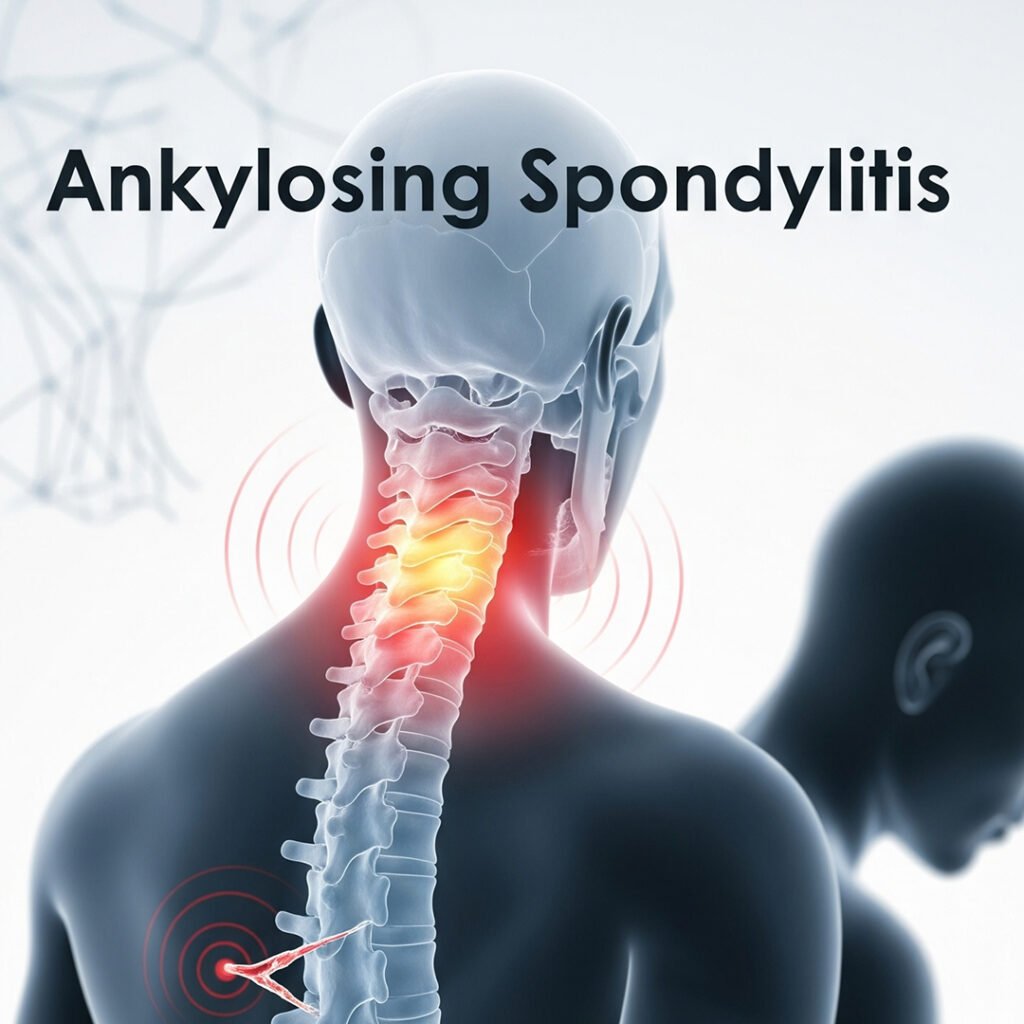Occasional chest pain due to rib joint involvement
Ankylosing spondylitis
Introduction
Ankylosing spondylitis (as) is an chronic, progressive inflammatory arthritis that mainly affects the spine and holy joints. This causes pain, hardness and low mobility due to the inflammation of the vertebrae, which can eventually lead to the fusion of the spine bones. As often begins in adulthood, men are more common, and have a strong genetic link, especially with HLA-B27 genes. Early diagnosis and treatment are important to prevent severe deformity and maintain quality of life.

Types of Ankylosing Spondylitis
Axial Ankylosing Spondylitis
Mainly affects the spine and holy joints. Symptoms include chronic back pain, morning stiffness and spinal flexibility. Over time, it can cause full spinal cord fusion.
Peripheral angilizing spondylitis
Joints are included outside the spine, such as shoulders, hip, knee, or ankle. Combined swelling, pain, and hardness are common, sometimes accompanied by symptoms of spinal cord.
Non-radiographic axial spondiloarthritis
The early stages of the AS where the symptoms exist, but do not show the X-ray visible joint damage. MRI may reveal inflammation before bone changes.
Adolescent ankyloging spondylitis
Developed in children or adolescents, usually begins with pain and inflammation in the hips, knees, or ankles, and later affects the spine. It can progress to the classic as adulthood.
Causes of Ankylosing Spondylitis
- Genetic instincts, especially the presence of HLA-B27 genes
- Immune system malfunction causes inflammation in joints and ligaments
- Ankyloging spondylitis or family history of arthritis
- Previous gastrointestinal or urinary tract infections trigger inflammation
- Environmental factors that may activate genetic susceptibility
- Highly active immune response attacks body tissue
- History of swelling bowel disease increases
- Chronic stress contributes to immune laxity
Clinical features of Ankylosing Spondylitis:
Chronic Back Pain and Stiffness
Constant pain and stiffness in the back and buttocks, often in the morning or after inactivity, improves with exercise.
Spinal flexibility low
The limited range of motion in the spine due to inflammation and final fusion of the vertebrae makes it difficult to bend or rotate.
Peripheral joint pain
Swelling, pain and hardness in joints such as hips, shoulders, knees, or ankles, sometimes accompanied by symptoms of spinal cord.
Postural change
Progressive spinal cord fusion can lead to a stop or further inclination posture especially in the advanced stages of the disease.
Fatigue and general discomfort
Chronic inflammation and pain can lead to frequent fatigue, energy levels, and a common sense of unhealthy.
Symptoms associated with Ankylosing Spondylitis
- Persistent lower back and buttock pain
- Morning stiffness that improves with movement
- Swelling and pain in hips, knees, or shoulders
- Reduced flexibility in the spine
- Stooped or forward-bent posture
- Fatigue and low energy levelsLoss of appetite.
- Pain worsening after rest or inactivity
Investigations in Ankylosing Spondylitis
- A hallmark characteristic of X-ray secularus, sclerosis, or cacraliactic joints, a hallmark characteristics of ankyloging spondylitis helps to detect sekroilitis.
The MRI can detect initial inflammatory changes in the joints and spine before appearing on X-rays, making it useful for early diagnosis and monitoring of the disease.
ESR is a blood test that indicates inflammation. Elevated ESR levels may suggest active disease, but it is not specific for ankylizing spondylitis.
CRP is another inflammatory marker. The high CRP level can indicate inflammation in ankylizing spondylitis and help to assess the treatment reaction.
HLA-B27 is a genetic marker that is firmly associated with ankylizing spondylitis. Its presence increases the risk but is not confirmed without clinical and imaging findings.
CBC can reveal the anemia of chronic disease, which can be caused by prolonged inflammation in ankyloging spondylitis, and helps in overall patient evaluation.
BMD assessment examines for osteoporosis or low bone strength, which may develop in long -standing ankylizing spondylitis due to chronic inflammation and immobility.
RF is usually negative in ankyloging spondylitis, helps to separate it from rheumatism, which usually has a positive RF result.
Ultrasound detects inflammation, inflammation or calcifications on the tendon and ligament attachment sites, which is common in ankylizing spondylitis.
PFT can be done in advanced cases to assess restrictive lung changes due to spinal hardness and low chest expansion
